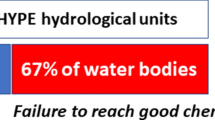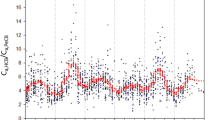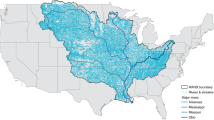Abstract
Background
Thousands of chemicals are observed in freshwater, typically at trace levels. Measurements are collected for different purposes, so sample characteristics vary. Due to inconsistent data availability for exposure and hazard, it is complex to prioritize which chemicals may pose risks.
Objective
We evaluated the influence of data curation and statistical practices aggregating surface water measurements of organic chemicals into exposure distributions intended for prioritizing based on nation-scale potential risk.
Methods
The Water Quality Portal includes millions of observations describing over 1700 chemicals in 93% of hydrologic subbasins across the United States. After filtering to maintain quality and applicability while including all possible samples, we compared concentrations across sample types. We evaluated statistical methods to estimate per-chemical distributions for chosen samples. Overlaps between resulting exposure ranges and distributions representing no-effect concentrations for multiple freshwater species were used to rank estimated chemical risks for further assessment.
Results
When we apply explicit data quality and statistical assumptions, we find that there are 186 organic chemicals for which we can make screening-level estimates of surface water chemical concentration. Of the original 1700 observed chemicals, this number decreased primarily due to a predominance of censored values (that is, observations indicating concentrations too low to be measured). We further identify 423 chemicals where all measurements were censored but, through consideration of detection limits, risk might still be prioritized based on the detection limits themselves. In the final set of 1.5 million samples, the median environmental concentration of one chemical (acetic acid) exceeded the 5th percentile of no-effect concentrations for the most delicate freshwater species (the highest priority risk condition identified here), and a further 29 chemicals were identified for possible further evaluation based on a small margin between occurrence and toxicity values.
Significance
This method shows the broad range of chemical concentrations seen for organic chemicals across the country and identifies methods of determining their central tendency, allowing for researchers to characterize higher-than-normal or lower-than-normal surface water conditions as well as providing an overall indication of the presence of organic chemicals in the United States. The highest chemical concentrations did not always indicate the highest-risk conditions. Even when accounting for the high level of uncertainty in these data due to differences in data collection and reporting across the set, some chemicals may still be categorized as higher environmental risk than others using this method, providing value to chemical safety decision makers and researchers by suggesting avenues for more focused investigation.
This is a preview of subscription content, access via your institution
Access options
Subscribe to this journal
Receive 6 print issues and online access
$259.00 per year
only $43.17 per issue
Buy this article
- Purchase on Springer Link
- Instant access to full article PDF
Prices may be subject to local taxes which are calculated during checkout






Similar content being viewed by others
Data availability
The initial analysis set was downloaded from https://www.waterqualitydata.us/ using queries described in the file load_water_data.py, hosted at https://github.com/USEPA/EcoSEEM-Consensus-Model-for-Chemicals-in-Surface-Water/tree/master/observation_data. The representative concentration ranges and bioactivity:exposure ratio results are available at the same GitHub repo in the file all_chem_res.csv.
References
National Research Council. Risk assessment in the federal government: managing the process. Washington (DC): National Academies Press (US); 1983.
Zartarian V, Bahadori T, McKone T. Adoption of an official ISEA glossary. J Expo Anal Environ Epidemiol. 2005;15:1–5. https://doi.org/10.1038/sj.jea.7500411.
Judson R, Richard A, Dix DJ, Houck K, Martin M, Kavlock R, et al. The toxicity data landscape for environmental chemicals. Environ Health Perspect. 2009;117:685–95. https://doi.org/10.1289/ehp.0800168.
Egeghy PP, Judson R, Gangwal S, Mosher S, Smith D, Vail J, et al. The exposure data landscape for manufactured chemicals. Sci Total Environ. 2012;414:159–66. https://doi.org/10.1016/j.scitotenv.2011.10.046.
Kavlock RJ, Bahadori T, Barton-Maclaren TS, Gwinn MR, Rasenberg M, Thomas RS. Accelerating the pace of chemical risk assessment. Chem Res Toxicol. 2018;31:287–90. https://doi.org/10.1021/acs.chemrestox.7b00339.
Turley AE, Isaacs KK, Wetmore BA, Karmaus AL, Embry MR, Krishan M. Incorporating new approach methodologies in toxicity testing and exposure assessment for tiered risk assessment using the RISK21 approach: case studies on food contact chemicals. Food Chem Toxicol. 2019;134:110819. https://doi.org/10.1016/j.fct.2019.110819.
Parish ST, Aschner M, Casey W, Corvaro M, Embry MR, Fitzpatrick S, et al. An evaluation framework for new approach methodologies (NAMs) for human health safety assessment. Regul Toxicol Pharm. 2020;112:104592. https://doi.org/10.1016/j.yrtph.2020.104592.
Wambaugh JF, Bare JC, Carignan CC, Dionisio KL, Dodson RE, Jolliet O, et al. New approach methodologies for exposure science. Curr Opin Toxicol. 2019;15:76–92. https://doi.org/10.1016/j.cotox.2019.07.001.
Arnot JA, Mackay D, Webster E, Southwood JM. Screening level risk assessment model for chemical fate and effects in the environment. Environ Sci Technol. 2006;40:2316–23. https://doi.org/10.1021/es0514085.
Barber MC, Isaacs KK, Tebes-Stevens C. Developing and applying metamodels of high resolution process-based simulations for high throughput exposure assessment of organic chemicals in riverine ecosystems. Sci Total Environ. 2017;605-606:471–81. https://doi.org/10.1016/j.scitotenv.2017.06.198.
Rosenbaum RK, Huijbregts MAJ, Henderson AD, Margni M, McKone TE, van de Meent D, et al. USEtox human exposure and toxicity factors for comparative assessment of toxic emissions in life cycle analysis: sensitivity to key chemical properties. Int J Life Cycle Assess. 2011;16:710. https://doi.org/10.1007/s11367-011-0316-4.
Schmolke A, Thorbek P, Chapman P, Grimm V. Ecological models and pesticide risk assessment: current modeling practice. Environ Toxicol Chem. 2010;29:1006–12. https://doi.org/10.1002/etc.120.
Arnot JA, Brown TN, Wania F, Breivik K, McLachlan MS. Prioritizing chemicals and data requirements for screening-level exposure and risk assessment. Environ Health Perspect. 2012;120:1565–70. https://doi.org/10.1289/ehp.1205355.
MacLeod M, Scheringer M, McKone TE, Hungerbuhler K. The state of multimedia mass-balance modeling in environmental science and decision-making. Environ Sci Technol. 2010;44:8360–4. https://doi.org/10.1021/es103297w.
Mitchell J, Arnot JA, Jolliet O, Georgopoulos PG, Isukapalli S, Dasgupta S, et al. Comparison of modeling approaches to prioritize chemicals based on estimates of exposure and exposure potential. Sci Total Environ. 2013;458-460:555–67. https://doi.org/10.1016/j.scitotenv.2013.04.051.
Wambaugh JF, Setzer RW, Reif DM, Gangwal S, Mitchell-Blackwood J, Arnot JA, et al. High-throughput models for exposure-based chemical prioritization in the ExpoCast project. Environ Sci Technol. 2013;47:8479–88. https://doi.org/10.1021/es400482g.
Fryer M, Collins CD, Ferrier H, Colvile RN, Nieuwenhuijsen MJ. Human exposure modelling for chemical risk assessment: a review of current approaches and research and policy implications. Environ Sci Policy. 2006;9:261–74. https://doi.org/10.1016/j.envsci.2005.11.011.
Hommen U, Baveco JM, Galic N, van den Brink PJ. Potential application of ecological models in the European environmental risk assessment of chemicals. I. Review of protection goals in EU directives and regulations. Integr Environ Assess Manag. 2010;6:325–37. https://doi.org/10.1002/ieam.69.
Ring CL, Arnot JA, Bennett DH, Egeghy PP, Fantke P, Huang L, et al. Consensus modeling of median chemical intake for the U.S. population based on predictions of exposure pathways. Environ Sci Technol. 2019;53:719–32. https://doi.org/10.1021/acs.est.8b04056.
Hirsch RM, Fisher GT. Past, present, and future of water data delivery from the U.S. Geological Survey. J Contemp Water Res Educ. 2014;153:4–15.
Read EK, Carr L, DeCicco LA, Dugan H, Hanson PC, Hart JA, et al. Water quality data for national-scale aquatic research: the Water Quality Portal. Water Resour Res. 2017;53:1735–45. https://doi.org/10.1002/2016WR019993.
Sprague LA, Oelsner GP, Argue DM. Challenges with secondary use of multi-source water-quality data in the United States. Water Res. 2017;110:252–61.
Grulke CM, Williams AJ, Thillanadarajah I, Richard AM. EPA’s DSSTox database: history of development of a curated chemistry resource supporting computational toxicology research. Comput Toxicol. 2019;12. https://doi.org/10.1016/j.comtox.2019.100096.
Williams AJ, Grulke CM, Edwards J, McEachran AD, Mansouri K, Baker NC, et al. The CompTox Chemistry Dashboard: a community data resource for environmental chemistry. J Cheminform. 2017;9:61. https://doi.org/10.1186/s13321-017-0247-6.
Lucijanic M, Skelin M, Lucijanic T. Survival analysis, more than meets the eye. Biochem Med. 2017;27:14–8.
Millard SP. EnvStats: an R package for environmental statistics. New York: Springer; 2013.
Neuhaus G. Conditional rank tests for the two-sample problem under random censorship. Ann Stat. 1993;21:1760–79. http://www.jstor.org/stable/2242315.
Helsel DR. Fabricating data: how substituting values for nondetects can ruin results, and what can be done about it. Chemosphere. 2006;65:2434–9. https://doi.org/10.1016/j.chemosphere.2006.04.051.
Shoari N, Dubé JS. Toward improved analysis of concentration data: embracing nondetects. Environ Toxicol Chem. 2018;37:643–56. https://doi.org/10.1002/etc.4046.
Helsel DR, Hirsch RM, Ryberg KR, Archfield SA, Gilroy EJ. 2020, Statistical methods in water resources: techniques and methods. Reston, VA: U.S. Geological Survey; 2020. p. 458. Report 4-A3. https://doi.org/10.3133/tm4a3.
Zhong M, Hess KR. Mean survival time from right censored data. Working Paper 66. COBRA Preprint Series; 2009. http://biostats.bepress.com/cobra/art66.
U.S. Environmental Protection Agency. ECOTOX user guide: ECOTOXicology Knowledgebase System. Version 5.3. 2020. http://www.epa.gov/ecotox/.
Posthuma L, van Gils J, Zijp MC, van de Meent D, de Zwart D. Species sensitivity distributions for use in environmental protection, assessment, and management of aquatic ecosystems for 12386 chemicals. Environ Toxicol Chem. 2019;38:905–17. https://doi.org/10.1002/etc.4373.
Mansouri K, Grulke CM, Judson RS, Williams AJ. OPERA models for predicting physicochemical properties and environmental fate endpoints. J Cheminform. 2018;10:10. https://doi.org/10.1186/s13321-018-0263-1.
George BJ, Gains-Germain L, Broms K, Black K, Furman M, Hays MD, et al. Censoring trace-level environmental data: statistical analysis considerations to limit bias. Environ Sci Technol. 2021;55:3786–95.
Acknowledgements
The authors thank Dr. Jon Arnot, Ms. Lindsay Eddy, Ms. Colleen Elonen, and Dr. Peter Fantke for their helpful reviews of the manuscript.
Funding
The United States Environmental Protection Agency (EPA) through its Office of Research and Development (ORD) funded the research described here. This project was supported in part by an appointment to the Research Participation Program at the Center for Computational Toxicology and Exposure, U.S. Environmental Protection Agency, administered by the Oak Ridge Institute for Science and Education through an interagency agreement between the U.S. Department of Energy and EPA.
Author information
Authors and Affiliations
Contributions
The original concept for this analysis is based on work by RWS. All authors here were working together on another project; the idea for making this a stand-alone manuscript was identified by JFW and RRS. RRS wrote the text of the article, along with JFW. RRS wrote the extraction script. A first idea for the analysis script was written by RWS (although the current work uses different methods). RRS conceptualized and wrote the current analysis script, with assistance from JFW and RWS. MLS and RWS provided guidance on statistical methods. All authors reviewed and approved both the work as it progressed and the final form of the manuscript.
Corresponding author
Ethics declarations
Competing interests
The authors declare no competing interests.
Additional information
Publisher’s note Springer Nature remains neutral with regard to jurisdictional claims in published maps and institutional affiliations.
Rights and permissions
About this article
Cite this article
Sayre, R.R., Setzer, R.W., Serre, M.L. et al. Characterizing surface water concentrations of hundreds of organic chemicals in United States for environmental risk prioritization. J Expo Sci Environ Epidemiol 33, 610–619 (2023). https://doi.org/10.1038/s41370-022-00501-1
Received:
Revised:
Accepted:
Published:
Issue Date:
DOI: https://doi.org/10.1038/s41370-022-00501-1



